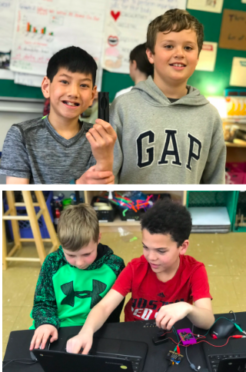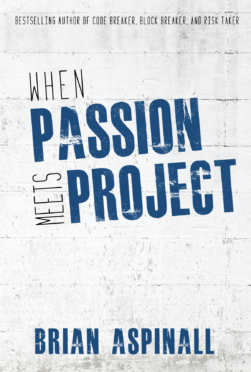By Jeff Hennigar, @MrHennigar
This past December, I agreed to take part in a project that would become the most community-involved in-school project that I’ve been a part of. A colleague from Brilliant Labs, Sarah Ryan, suggested I work with her on a project in conjunction with the Neil Squire Society; an organization that works to empower people living with physical disabilities. Sarah proposed the idea of having the my 5th graders design and 3D print assistive devices. I did some digging and found out that 3D printing assistive devices is at least 90% more cost effective than buying them commercially. For someone living with a condition such as arthritis, there are countless assistive devices that can make simple tasks easier, but they can be quite costly. The group Makers Making Change has a bank of pre-designed models that are open source and can be 3D printed at a very little cost. My 5th graders have become very comfortable designing things in Maker’s Empire and TinkerCAD through a project where we designed, printed, and sold holiday ornaments to raise money for our local children’s hospital. But this idea was so much more than a 3D printing project.

Deep Learning
The “4Cs” has been a popular phrase in education for years, recognizing the importance of teaching and allowing the practice of collaboration, critical thinking, communication, and creativity. I believe it is through these “soft skills” that students develop love of learning. Earlier this school year I was invited to take part in a pilot project in my district to explore and implement the ideas of Michael Fullan as outlined in his program, New Pedagogies for Deep Learning. Fullan adds to the 4Cs to include two more: citizenship and character education. Fullan suggests stretching empathy and kindness outside the classroom walls to connect with the community, and how this should be a fundamental aspect of learning. The idea is to emotionally connect students to what they are learning and fill them with purpose. There are countless success stories following his model around the world, it’s worth checking out!
Thank you Courtney and Mohammed from the @NeilSquireSoc for visiting us. We were so inspired by your work with assistive devices–we can’t wait to make our own! Prototypes are coming 🙂#MakersMakingChange #HRCEdeeplearning #SeeWhatImLearning @brilliant_labs @sarah_sarahryan https://twitter.com/MrHennigar/status/1100837754068484096/photo/1pic.twitter.com/S8BtHaxedw
— Jeff Hennigar (@MrHennigar) February 27, 2019
Community Connections
During the two weeks we were learning about a variety of physical conditions and we had numerous guests in the classroom. Parent visitors discussed cystic fibrosis and cerebral palsy, a student’s family friend came in to teach us about daily life with rheumatoid arthritis, a representative from the Canadian Arthritis Society, and I arranged 2 Google Hangout with colleagues at different schools so we could meet their students and find out what kind of devices could help them in their daily lives.
Designing assistive devices for people in our school and community. #HRCEdeeplearning#SeeWhatImLearning@TILTHRCE @MakersEmpire @tinkercad @Polar3D @NewPedagogies @brilliant_labs @NeilSquireSoc @MakerMakeChange https://twitter.com/MrHennigar/status/1101199471025815553/photo/1pic.twitter.com/wsgdivOM9s
— Jeff Hennigar (@MrHennigar) February 28, 2019
I wanted each group’s project to have a person in mind; they weren’t just going to make this for anyone, they were making it for someone they have met! As students moved into the research phase, we invited representatives from Brilliant Labs and The Neil Squire Society to help us launch into our prototyping. They showed us more examples of devices that are helpful to people living with specific conditions and we used this as a springboard and inspiration into our own designs.
As expected, the variety of projects was wide and personal. Many students had their family members in mind while designing. Several made devices for people with arthritis, or for the students we met via Google Hangout.
Report this message sent 3 minutes ago from Jeff Hennigar Delete this message sent 3 minutes ago from Jeff HennigarThank you Kim for coming in yesterday to talk to us about cystic fibrosis! https://twitter.com/MrHennigar/status/1104119988112232448/photo/1pic.twitter.com/8BFwsJTpej
— Jeff Hennigar (@MrHennigar) March 8, 2019
Final Products
I love maker projects like this because students get to practice the mindset that things can be improved through feedback and trial & error. One group 3D printed a pencil grip design at least 8 times to get it right. After all, the goal wasn’t just to make a device, it was to make a device that someone in our community could actually use! In the end, we had several devices for holding pencils and markers, a video, fidgets, a cane (3D printed in segments), utensil grips, grocery bag hooks, key holders, a medicine storage container, and even a MicroBit proximity sensor to keep someone with vision impairment safe from hazardous areas such as the top of stairs. These 10 and 11-year-olds were learning grade level curriculum that had a greater purpose than anything I’ve ever been a part of before.



We sent prototypes to students and adults in our community and beyond. For the students to hear back about how their device was being used was very powerful. We received photos of them in use and letters of gratitude. It was a great way for the kids to see the impact of their work.
Looking Back
I felt throughout the project that what we were doing was valuable and time well spent. However, it wasn’t until a representative from my district office came to interview the students about their projects and I heard them explain to someone else how they felt about their work that I really understood how the layer of citizenship added a depth to the learning that I don’t think I could have achieved in another way. They fully understood what the project was intended to achieve.
When I think back to my own experience in elementary school, the things I remember most were things that I made. A log cabin diorama and a science fair project about recycling are the first things that come to mind. I think this will be one of those projects that students will remember and be proud of for a long time.

Jeff Hennigar, @MrHennigar
Grade 5 teacher at @BLTsenior with a passion for making mistakes. Google Certified lvl 2, @CoSpaces_edu ambassador, & @breakoutEDU trainer & game designer.#MakerEd

 For all the kids who grow up in a small town and think they don’t stand a chance. You do. I was once that kid.
For all the kids who grow up in a small town and think they don’t stand a chance. You do. I was once that kid.